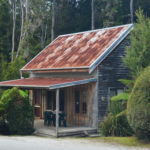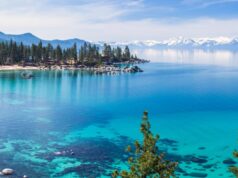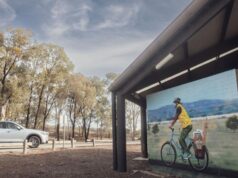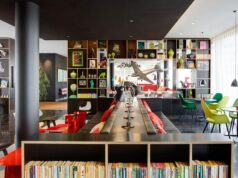Once forgotten, many Australian towns are undergoing unlikely revivals thanks to the work of dedicated people.
Photo credit: Ricky French
Everywhere you look, Australia is littered with the rotting remains of forgotten civilisation. Former thriving towns that have been long-buried by the bush or the desert, left to crumble and decay once the party was over, until nothing remains but rusty nails in the dirt. But some have risen from the dead. Led by passionate locals, visitors, artists, business owners and volunteers, many Australian towns have initiated projects to revive the glory days and bring the past alive again. Ricky French takes a look at five of the best.
Walhalla, Victoria
The first thing that strikes you about Walhalla, an unlikely town jammed up a mountain gully 180 kilometres east of Melbourne, is how un-Australian it is. On the surface it ticks all the boxes for an old Aussie ghost town: dried up gold mines, timber shacks, stone foundations of ruined pubs. But it’s the town’s European-like geography and climate that has helped to champion a revival.
At its peak in the late 1800s the population was 4000, but when the gold boom ended the town literally packed up shop, with residents dismantling their homes and shipping them off on the train, destined for anywhere else. It was cold, damp, stuck up a narrow valley; precisely the thing that makes it so appealing today, thanks to come clever ideas by locals.
In the last decade over 500 hundred deciduous trees were planted, to bring autumn and spring colour. The colour brings over 140,000 people to the town every year, quite a change from the depressing days when of yesteryear when the most it would attract would be a one of two intrepid Sunday afternoon drivers.
Michael Leaney kick-stated the town’s rebirth in the late 1990s by rebuilding the Star Hotel, which had burnt down in 1951. He thought, rather astutely, that it might be nice if visitors had somewhere to stay. Leaney’s commitment to honouring the town’s history has been infectious. The latest revamp has been a repaving of the road in brown bitumen, to make it appear like a gravel road. The renovated shops and museum, and the clean gardens, stone walls, old rotunda, campgrounds and bustling pub all combine to make Walhalla just about the prettiest thing you’ll see in Victoria. As Leaney’s partner Russell Wright says, “It’s like Switzerland in the alps – Australian bush surrounding English gardens and a European streetscape.”
Don’t miss out on the after-dark ghost tour, either, run by sixth-generation Walhallian Brian Brewer, where the dark underbelly of the pretty town is revealed.
Yerranderie, New South Wales
There’s a lot you should know about Yerranderie but probably the most important thing is don’t trust Google Maps to get you there. This secluded former silver-mining town may only be 100 kilometres from Sydney, but there’s no way to approach from the east – not since they drowned the Burragorang Valley in the 1950s to create a dam for Sydney’s water supply. It means a good old fashioned road trip through the Blue Mountains via Oberon is called for. Nothing wrong with that.
The flooding of the valley effectively sounded the death knell for the small township, which had its heyday in the early 1900s when a farmer digging a fencepost looked down at the hole in the ground and realised he was staring at silver ore, or so the story goes. It sparked a boom, but by the start of the First War World the demand for silver had plummeted and the town wound down. Today it’s a campers’ paradise, a gorgeous forest and woodland retreat, with many surviving houses that have been done-up for accommodation. Divided into two sections, known as government town and private town, there’s a picturesque campground with luxuries such as hot showers, flushing toilets, space for camping as well as more unique accommodation, such as the old post office. Scattered in the remains of the old town are several original houses, lovingly renovated and blooming through the trees like wildflowers. Fantastic photo-ops await at St Sanans Church, the old courthouse and the old police station. There are also privately-owned holiday houses that get rented out, so check the usual websites and you might find a gem there.
Geographically it’s a wondrous region, with sandstone cliffs towering above and hiking tracks leading off into the wooded hills. It’s a bird-watcher’s paradise, and you might just catch a glimpse of the critically endangered regent honeyeater.
To book ring the caretaker on (02) 4659 6165
Barcaldine, Queensland
“We quite enjoy the sea breezes here,” says Barcaldine mayor Rob Chandler. “We’re only 650 kilometres west of Rockhampton, it’s just a lazy 14 hour return drive for a dip in the ocean.”
The enigmatic mayor grew up on the land in western Queensland and knows a thing or two about a thousand things, including how to turn the fortunes of a declining town around. Barcaldine was a typical rural town with one unique feature – it was home of the “Tree of Knowledge.” The tree was a ghost gum in the middle of town that was the meeting point for the famous shearers strike of 1891. “It was the first Labour Day parade anywhere in the world,” says Chandler. “Those times really set about changing the political landscape in Australia.”
Not everyone liked the old tree, though, or what it stood for. In 2006 murder most foul was visited upon the sleepy town of Barcaldine. The old tree was poisoned in the middle of the night. The culprit was never caught.
But that was only the beginning of the story. The corpse was removed and shipped to Brisbane for embalming in a preserving chemical. Three years later it was reinstated back where it had always been, and an enormous artistic memorial was built around it. The project cost $8 million and features a 3600 timbers hung from a 19 square metre structure around the tree, in various lengths and forms, styled to recreate the canopy as it would have appeared in in the late 1800s. At night the canopy is illuminated by green spotlights, and the effect is magical. It wasn’t just a tree that came back from the dead, it was an entire town.
“It increased visitor numbers by over 50 per cent,” says Chandler, who reckons the murder inadvertently did the town a favour, turning the place into a tourist destination. Chandler was also instrumental in restoring the old Globe Hotel into an art gallery, visitor centre and history room. “People don’t want to come here to see a brick retro building, they want to see a historic pub that’s been done up in line of how it used to be like.” Trees and buildings may draw people in, but it’s the people who are the heart of the town. “This is pure outback. The people are genuine. The best thing you can do is pull up a chair at the pub and say to the person next to you, ‘what’s going on, mate?’ We need to instil an infinity with the bush in the hearts of city people. It would be a tragedy if we lost that.”
Farina, South Australia
A former railway town on the edge of the hostile South Australian outback, Farina was settled in the 1880s when the original Ghan train passed through. It grew to around 300 people around 1900, then began to decline as roads became established and cattle stopped passing through. By the 1950s it was abandoned like so many other outback towns. That might have been where the story ended if it wasn’t for a group of people who took it upon themselves to preserve what was left of the place.
Bob Brownlee is part of the Farina Restoration Project. He’s been coming to Farina for nearly twenty years to work on maintaining what’s left of the ten iconic buildings. They’ve marked out the old railway lines and restored the famous underground bakery. “Retired bakers come out and run it. We bake everything from bread to rolls to sweet treats to cream buns. If you don’t like our pies you can go across the road – it’s only 400 kilometres away.”
Today the permanent population is two, but over winter the place swells with caravaners and campers flocking to stay at the campground, soak up the outback atmosphere and stroll around the stone relics of the town. Brownlee says towns like Farina shouldn’t be condemned to ruin. “I’m passionate that future generations should see what an inland town was like. This town is part of our heritage. You drive up from Adelaide and see all these old buildings falling down; it’s sad. If we hadn’t come along Farina would be rubble, too.”
From Farina visitors head off into the Simpson Desert, or to Birdsville or Marree, to drive the Oodnadatta Track, all to get a taste Australia’s magical interior. Farina, with its barren, golden streets, story boards and it’s proud, crumbling glory, is part of that legend, and is well-worth more than just a pie-stop.
Corinna, Tasmania
If Walhalla is a little bit of Europe in Australia then Corinna is a slice of the Amazon. The wild west of Tasmania deserves to be flocking with tourists, but it remains a guarded secret. The town of Corinna, at the edge of the stunning Tarkine wilderness, dipping its toes into the broad and stately Pieman River, is unlike anywhere else. Its former life as a remote gold mining and logging hub is reflected in the restored log cabins and the dirt tracks running off into the rainforest. For such a sedate place it was a rough and bawdy township back in the day. You can rent the cabins (pick of them is the historic old pub) where you’ll feel like you’re living 100 years in the past. But luckily there’s a warm and inviting restaurant and bar within the reception building, staffed by a seasonally rotating team of sullen European backpackers. Cosy camping is also up for grabs at the water’s edge, and you can fish and watch sunset turn the river red. Adding to the isolated, jungle-like feel is the “Fatman” barge that takes you and your car across the river on your way in or out of town.
To really experience the Tarkine you have to get outside, and Corinna offers no shortage of incentives here, including a trip along the Pieman to the river’s mouth on the famous Arcadia II, a handsome boat built in 1939 out of huon pine. Exploring the Pieman is a must however you do it, and hiring a kayak and paddling to the mouth of the Savage River, where you can have a picnic lunch and explore a shipwreck at the old wharf is a day you’ll never forget.
If bushwalking is more your thing then a daytrip to the summit of Mount Donaldson will reward you with views across the Tarkine and out to the coast.
Corinna might have receded into the rainforest after its industry left, but thankfully it’s stuck around to remind us of how life used to be. Like most West Coast Tasmania towns its future lies in eco-tourism, and with a town as captivating as this the future is brighter than the gold once dug from the hills.



